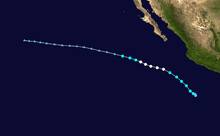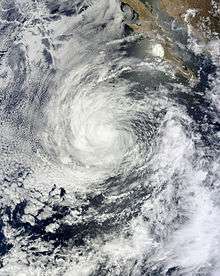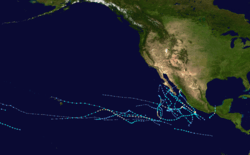Hurricane Cosme (2013)
| Category 1 hurricane (SSHWS/NWS) | |
 Hurricane Cosme on June 25, 2013 | |
| Formed | June 23, 2013 |
|---|---|
| Dissipated | July 1, 2013[1] |
| (Remnant low after June 27) | |
| Highest winds |
1-minute sustained: 85 mph (140 km/h) |
| Lowest pressure | 980 mbar (hPa); 28.94 inHg |
| Fatalities | 3 confirmed |
| Damage | Minimal |
| Areas affected | Revillagigedo Islands, Western Mexico, Baja California Peninsula |
| Part of the 2013 Pacific hurricane season | |
Hurricane Cosme was the third named tropical cyclone of the 2013 Pacific hurricane season. The storm system formed on June 23 as a tropical depression approximately five hundred miles south of Manzanillo, Mexico. The cyclone became a tropical storm on June 24, and soon after formed into a hurricane on June 25. While initially stationary, the storm system started to move in a north westerly direction,[2] causing Mexican National Weather Service to issue a blue alert (minimum risk) hurricane warning for the states of Guerrero, Nayarit, and Baja California Sur; and a green alert (Low Risk) hurricane warning for the states of Michoacan, Jalisco, and Colima.[3][4]
The first damage caused by Hurricane Cosme occurred on the Revillagigedo Islands where the storm system created 42 mph winds. As The storm system moved towards Mexico it caused heavy rains and flooding within the state of Guerro. These rains also resulted in 24 landslides within the state. In Colima flooding resulted in the structural damage of several public facilities, private buildings, and approximately fifty homes. At least two people died as a result of the storm system. The first was a tourist who drowned in Zihuatanejo. The second was a police officer who was killed in an automobile accident that also injured 19 others.[5][6][7][8]
Hurricane Cosme arrived at its greatest intensity (75 kt) at approximately 0000 UTC on June 26 about 345 miles southwest of Cabo San Lucas, Mexico. Subsequently, stable air and lower water temperatures caused the storm to lose strength. The system continued to weaken and moved in a westward direction where it eventually weakened into a low pressure surface through approximately 1400 miles south east of the Hawaiian Islands.[9]
Meteorological history

Hurricane Cosme can be traced to a tropical wave that formed on the west coast of Africa on or around the 8th of June. That westward moving wave, which was also responsible for the formation of Tropical Storm Barry in the South Caribbean Sea, eventually reached the Eastern Pacific Ocean. The progress of the wave was slowed by a southwesterly movement within the Intertropical Convergence Zone.[10] During the morning hours of June 20, the National Hurricane Center (NHC) began monitoring a broad area of disturbed weather several hundred miles southeast of Acapulco, Mexico.[11] Assessed with a low chance of tropical cyclone formation within a two-day interval, conditions at the time were unfavorable but expected to become more conducive for development over subsequent days.[12] As the disturbance tracked generally west-northwestward, a broad area of low pressure developed; the NHC increased the chances of formation accordingly.[13] Convection – shower and thunderstorm activity – became steadily concentrated around the low-level center and spiral banding became evident; following a series of satellite and microwave images, the system was designated as Tropical Depression Three-E at 1500 UTC on June 23.[14] After the time of formation, the NHC stated that, "the largest negative factor is probably the size of the depression...which could keep it from rapidly intensifying."[15] The depression did not become better organized initially, with meager central convection and a lack of well-defined cloud features; by early on June 24, however, shower and thunderstorm activity began forming over the center. Two Advanced Scatterometer (ASCAT) passes indicated several 39 to 43 mph (63 to 69 km/h) wind vectors, and the cyclone was upgraded to Tropical Storm Cosme as a result. A small central dense overcast-like feature was observed at the time.[16]
Tracking west-northwestward around the southwestern periphery of a mid-level ridge over central Mexico,[17] Cosme became better organized on June 24. A large area of very cold cloud-tops developed over and just southeast of the center of the storm, and convective banding wrapping into the mass began to form, mainly in the north and east semicircles.[18] Though the cloud pattern became elongated north to south during the pre-dawn hours of the following day,[19] a rapid improvement of the inner core on microwave and the structure on satellite imagery became apparent. A timely AMSU pass indicated an eyewall nearly closed with an accompanying intensity estimate of 77 mph (124 km/h), and a transient eye became visible on early morning satellite images. As a result, the National Hurricane Center upgraded Cosme to a Category 1 hurricane on the Saffir–Simpson hurricane wind scale.[20] Given the light wind shear, warm sea surface temperature, and moist air environment, the agency predicted further intensification for the following hours, and the system attained its peak intensity with winds of 85 mph (140 km/h) and a minimum barometric pressure of 981 mbar (hPa; 28.97 inHg) late on June 25.[21] Thereafter, a result of cooler sea surface temperatures forecast several days in advance, convection on the west side of the circulation center began to erode significantly.[22] The tropical storm wind radii expanded the following morning, but the inner core of Cosme, specifically the structure of the eye, began to degrade; the low-level circulation became decoupled with the upper-level circulation as well, and all thunderstorm activity dissipated.[23] Reduced to a swirl of low to mid-level clouds, winds decreased below tropical storm-force and deep convection did not reform over the center.[24] At 2100 UTC on June 27, the NHC declared Cosme as a post-tropical cyclone.[25] The remnant low of Cosme continued northwestward for the next several days, before degenerating into an open trough on July 1.[1]
Preparations and forecasting

Mexican news organizations and government agencies began reporting on the progress of Hurricane Cosme as early as the 24th of June. SINAPROC issued various warnings regarding the storm on the 24th and 25 of June. Mexican authorities remained active throughout the disturbance and Government officials began surveying and rebuilding damaged infrastructure as early as the 27th of June. Multiple ports closed down small craft operation because of the weather.[26][27] At least one death was caused when a tourist ignored these closures and was thrown overboard while operating a small boat during the storm.[28]
When Cosme became a tropical storm on the 24th of June the Mexican National Weather Service (Servicio Meteorologico Nacional NWS)reported that it could create heavy rains in the western area of the country. Rainfall as a result of the storm was predicted to range from "intense" (70 to 150 liters per square meter) to "heavy" (greater than 150 liters per square meter) in the states of Colima, Jalisco, Guerrero, Michoacan, and Oaxaca. The NWS also that "because of its wide circulation, [Comse] generates significant potential for landslides and intense rain...waves 4 to 5 meters high and strong gusts of wind along the coast." [29] Based on these forecasts the National Civil Protection System (SINAPROC) initially issued a green alert "low risk" hurricane warning within the states of Jalisco, Michoacan, and Colima, as well as a blue alert "minimum risk'hurricane warning for the states of Nayarit and Guerrero.[3] The continued strengthening of Cosme caused SINAPROC to issue a blue alert to Baja California Sur, stating that the system has strong potential to cause heavy rains despite its relatively long distance off shore.[4]
According to the NOAA, Hurricane Cosme was well forecast. Several global weather models predicted the formation of the storm system about a week prior to the storm's formation. A "high chance of formation" was issued 36 hours prior to the genesis of the storm system. Official forecast track errors were lower than average for forecasts within the previous five year average. However, CLIPER errors were larger than average. Official intensity forecasts by the NHC were more accurate than the average accuracy for predictions within the last five years. There were no warnings issued within the United States as a result of Hurricane Cosme.[30]
The NOAA and national hurricane center made heavy use of satellite imagery, advanced scatterometer (ASCAT), and Cooperative Institute for Mesoscale Meteorological Studies (CIMMS) observation data [31] to track, quantify, and forecast Hurricane Cosme.[32]
Impact
Hurricane Cosme caused minor, but widespread, damage on main land Mexico as it moved westward. Unstable structures, such as those made of wood and coconut, suffered the most damage as a result of the storm. Flooding was also a major cause of storm damage while multiple landslides caused road blockages.[7][8] Most of the injuries as a result of the storm came from automobile accidents that were operating during the inclement weathers, causing at least one death and 19 injuries.[5][6] As early as the 25th of June Hurricane Cosme was causing inclement weather on mainland Mexico. Heavy rains were reported in southwest and south central Mexico, becoming particularly severe in Michoacan. High waves were reported along the pacific coast from Cabo Corrientes, Jalisco to Acapulco, Guerrero.[33] Hurricane Cosme made landfall on Socorro Island (largest of the Revillagigedo Islands) in the late afternoon on the 25th, causing waves, strong winds, and gust of up to 67 kph. However, the small population located on the island cause damage to be minimal.[34] In Guerrero, Rain Caused by the Hurricane created at least 24 landslides black blocked state highways in several locations. Rains as a result of the storm system also resulted in flooding in the port city of Acapulco.[5] According to the Guerrero Civil Protection, 50 homes were damaged because of the storm as a result of flooding, specifically the overflow of streams in Tlapa River.[7] In Colima, flooding and strong tides caused by a storm surge attributed to Hurricane Cosme resulted in damage to 34 tourist facilities, according to the Secretary of State Economic Development, and possibly one death. Most of these facilities were located in the municipalities of Tecomny and Armory. During the storm the port of Manzanillo [26] and Mazatlan closed down for small craft operation [27]
Hurricane Cosme has been cited as the result of up to three deaths and several injuries. Two of the deaths caused by Hurricane Cosme occurred in Guerrero. The first was an auxiliary member of the Mexican Highway patrol whose vehicle collided with a truck on the Mexico City-Acapulco road during inclement weather. In addition to the one death four others were injured in the accident.[6] Another 19 injuries resulted from two similar accidents that were also attributed to weather caused by the Hurricane [35] The second death associated with the storm system was Guillermo Zúñiga Dominguez, 39, who was a tourist from Mexico City. While sailing offshore, high waves caused Dominquez's boat capsize, at which point he was thrown over board, lost consciousness, and drowned. Dominguez body was discovered when it washed up on the shore of a local beach in Zihuatanejo.[36] In the wake of the storm system, the body of a middle aged man was discovered on a beach in Cuyutlan, Colima. However, it is questionable whether or not he was killed as a result of the hurricane because his injuries indicate that he had been dead for several days.[8]
See also
References
- 1 2 Andrew Levine (July 1, 2013). "Tropical Weather Discussion". National Hurricane Center. National Oceanic and Atmospheric Administration. Retrieved July 12, 2013.
- ↑ Blake, Eric (10 September 2013). NHC Tropical Cyclone Report, Hurricane Cosme (EP032013) (PDF) (Report). National Oceanic and Atmospheric Administration. Retrieved 5 March 2014.
- 1 2 "Cosme Strengthens and moves away from Mexican Coast". El Universal United. El Universal. Retrieved 5 March 2014.
- 1 2 Rodriguez, Gladys. "BS Decrees Blue Alert for Hurricane Cosme". El Universal United. El Universal. Retrieved 5 March 2014.
- 1 2 3 Newsroom (25 June 2013). "Hurricane Cosme Leaves Two Dead in Guerrero". XEU.com. XEU. Retrieved 5 March 2014.
- 1 2 3 Agencies (25 June 2013). "Cosme Becomes Hurricane, Affects Guerrero". zocalo.com. Zocalo Saltillo. Retrieved 5 March 2014.
- 1 2 3 "Cosme Cyclone Moves Away from Mexico". Fahrenheitmagazine.com. Fahrenheit Magazine. 26 June 2013. Retrieved 5 March 2014.
- 1 2 3 Quiles, Alfredo (27 June 2013). "Damage to Beaches in Colima by Cosme". El Universal United. El Universal. Retrieved 5 March 2014.
- ↑ Blake, Eric (10 September 2013). NHC Tropical Cyclone Report, Hurricane Cosme (EP032013) (PDF) (Report). National Oceanic and Atmospheric Administration. Retrieved 5 March 2014.
- ↑ Stewart, Stacy (7 October 2013). NHC Tropical Cyclone Report, Tropical Storm Barry (Al022013) (PDF) (Report). National Oceanic and Atmospheric Administration. Retrieved 5 March 2014.
- ↑ Todd B. Kimberlain (June 20, 2013). "Graphical Tropical Weather Outlook". 2013 East Pacific Tropical Weather Outlook Archive. National Hurricane Center. Retrieved June 25, 2013.
- ↑ Eric S. Blake (June 21, 2013). "Graphical Tropical Weather Outlook". 2013 East Pacific Tropical Weather Outlook Archive. National Hurricane Center. Retrieved July 10, 2013.
- ↑ Eric S. Blake (June 21, 2013). "Graphical Tropical Weather Outlook". 2013 East Pacific Tropical Weather Outlook Archive. National Hurricane Center. Retrieved July 10, 2013.
- ↑ Eric S. Blake (June 23, 2013). Tropical Depression Three-E Public Advisory Number 1 (Report). National Hurricane Center. Retrieved July 10, 2013.
- ↑ Eric S. Blake (June 23, 2013). Tropical Depression Three-E Discussion Number 2 (Report). National Hurricane Center. Retrieved July 10, 2013.
- ↑ Stacy R. Stewart (June 24, 2013). Tropical Storm Cosme Discussion Number 4 (Report). National Hurricane Center. Retrieved July 10, 2013.
- ↑ Robbie J. Berg (June 24, 2013). Tropical Storm Cosme Discussion Number 5 (Report). National Hurricane Center. Retrieved July 10, 2013.
- ↑ Michael J. Brennan (June 24, 2013). Tropical Storm Cosme Discussion Number 6 (Report). National Hurricane Center. Retrieved July 10, 2013.
- ↑ Stacy R. Stewart (June 25, 2013). Tropical Storm Cosme Discussion Number 8 (Report). National Hurricane Center. Retrieved July 10, 2013.
- ↑ John L. Beven II (June 25, 2013). Hurricane Cosme Discussion Number 9 (Report). National Hurricane Center. Retrieved July 10, 2013.
- ↑ Richard J. Pasch; Michael Zelinsky (June 25, 2013). Hurricane Cosme Discussion Number 11 (Report). National Hurricane Center. Retrieved July 10, 2013.
- ↑ Stacy R. Stewart (June 26, 2013). Hurricane Cosme Discussion Number 12 (Report). National Hurricane Center. Retrieved July 10, 2013.
- ↑ Eric S. Blake (June 27, 2013). Tropical Storm Cosme Discussion Number 16 (Report). National Hurricane Center. Retrieved July 10, 2013.
- ↑ John L. Beven II (June 27, 2013). Tropical Storm Cosme Discussion Number 17 (Report). National Hurricane Center. Retrieved July 10, 2013.
- ↑ John L. Beven II (June 27, 2013). Post-Tropical Cyclone Cosme Discussion Number 18 (Report). National Hurricane Center. Retrieved July 10, 2013.
- 1 2 Quiles, Alfredo (26 June 2013). "Cosme Damaged beach restaurants in Colima". El Universal United. El Universal. Retrieved 5 March 2014.
- 1 2 Gaxiola, Yovana (26 June 2013). "Mazatlan port closed by Cosme effects". El Universal United. El Universal. Retrieved 5 March 2014.
- ↑ Covarrubias, Adriana (25 June 2013). "Hurricane Cosme Kill Two in Guerrero". El Universal United. El Universal. Retrieved 5 March 2014.
- ↑ "Prevent Rain in 5 States by Storm Cosme". El Universal United. El Universal. Retrieved 5 March 2014.
- ↑ Blake, Eric (10 September 2013). NHC Tropical Cyclone Report, Hurricane Cosme (EP032013) (PDF) (Report). National Oceanic and Atmospheric Administration. Retrieved 5 March 2014.
- ↑ Stewart (24 June 2013). "CIMMS, a NOAA/OU Cooperative Institute". nhc.noaa.gov. NOAA. Retrieved 5 March 2014.
- ↑ "Tropical Storm COSME". cinns.ou.edu. CIMMS. 24 February 2014. Retrieved 5 March 2014.
- ↑ "La Pensa, Already a hurricane, Comse away from Mexico". La Pensa. Editorial Mexicana. Retrieved 5 March 2014.
- ↑ Sayan, Luciana (25 June 2013). "The Cosme Mexico Storm Became a Hurricane". Publimetr.pe. Publimetr. Retrieved 5 March 2014.
- ↑ "Hurricane Cosme, raging in the Pacific Ocean about 660 miles off the coast of Mexico, has claimed two lives, reported the authorities of Guerrero state.". voiceofrussia.com. Voice of Russia. 26 June 2013. Retrieved 5 March 2014.
- ↑ Covarrubias, Adriana (25 June 2013). "Hurricane Cosme Kill Two in Guerrero". El Universal United. El Universal. Retrieved 5 March 2014.
External links
| Wikimedia Commons has media related to Hurricane Cosme (2013). |
- National Hurricane Center Hurricane Tropical Cyclone Report: Hurricane Cosme
- National Hurricane Center Hurricane Tropical Cyclone Report: Tropical Storm Barry
- Climatologia Fitosanitaria report: Hurricane Cosme (Spanish)
- National Hurricane Center
- Servicio Meteorologico Nacional (Mexico National Weather Service) (Spanish)
